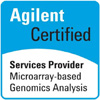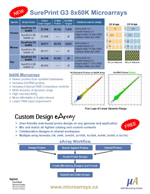home
 services
services  platforms
platforms  agilent: overview & faq
agilent: overview & faq
The UHN Microarray Centre is Canada's first Agilent Certified Microarray Service Provider and one of several
selected centres in the world. Our qualified technicians have participated in a rigorous certification programme
to ensure the customer is given the best possible service.
|
Services at a glance:
- Dual-Mode (1-colour or 2-colour) Gene Expression
- Oligo aCGH
- ChIP-on-chip
- DNA Methylation
- miRNA
- Custom arrays for all of the above applications
- Array scanning
Pricing: Download
![]()
Please note that this pricing is for academic groups.
Commercial customers should contact us for a quote.
General Contact:
Agilent Service Coordinator:
Monika Sharma
(416) 581-7441
Please note that special paperwork is required for shipping
RNA from locations outside of Canada. For the Customs documentation that you will need,
please download this form
![]() . Once you send us this information, the UHN
Customs Officer will generate the appropriate Customs document and send it to you via e-mail.
This document must be included with the waybill on your package.
. Once you send us this information, the UHN
Customs Officer will generate the appropriate Customs document and send it to you via e-mail.
This document must be included with the waybill on your package.
Quick questions:
 Expand all
Expand all
 Hide all
Hide all
- How much total RNA (or DNA) is required?
2 µg of total RNA (minimum concentration of 0.5 µg/uL) is required for gene expression experiments; ChIP-chip requires 4 µg amplified DNA; DNA methylation requires 2 µg PCR amplified or genomic DNA; aCGH requires 3µg DNA; and miRNA experiments require 100 ng total RNA. Please contact us prior to shipping any samples to verify amounts/concentrations required.
- What is the difference between a technical replicate and a biological replicate? Which type is best?
A biological replicate involves isolating RNA independently from replicate sources (multiple patients, multiple biopsies from an individual patient, etc). The purpose of a biological replicate is to control for biological diversity. Biological replicates are often more telling, and for this reason are “better” than technical replicates, however, biological replicates are often more difficult to obtain.
A technical replicate would be a multiple labeling or reciprocal labelling of the same RNA sample. This replicate may be useful in some cases (when one slide has poor signal for example) but it has little true statistical value when the experiment works.- What are the advantages and disadvantages between 1-colour and 2-colour hybridisations?
The decision to use 1-colour or 2-colour is mainly a factor of the experimental design and the question being asked. 1-colour experiments are cheaper as often times fewer arrays are required and less labelling reagents are required. 2-colour experiments generate results in a ratio format rather than absolute numbers so that there is more confidence in features that have low signal intensities. This also means that any variation between arrays is automatically accounted for. In theory, twice as much information is available from 2-colour experiments. However, 1-colour experiments often have less noise.
- What does it mean to be a “Certified Service Provider”?
Agilent selects a small number of service labs the ability to follow a rigorous certification process. This involves addition on-site training as well as assessing technical ability throughout the protocols. This process is required for all 4 platforms (Gene Expression, ChIP-on-Chip, aCGH and miRNA). Click here to learn more about what it means to be an Agilent Certified Service Provider.
- Is there an amplification kit available for small samples (nanogram range)?
The Low RNA Input Fluorescent Linear Amplification Kit can handle samples sizes as low as 50 ng.
- How are the RNA samples labelled?
Samples are labelled using Agilent’s Low RNA Input Amplification kit designed for each platform.
- Are there controls spotted on the Agilent arrays?
Yes. Some act as negative controls (just spotting solution) and there is also a set of positive controls that are spiked into the hyb cocktail.
- What software is used for data analysis?
GeneSpring GX is a powerful visualisation and analysis solution designed for use with expression data. Software provides advanced statistical tools, a range of visualization displays (scatterplots, pathway diagrams, and more), and data quality evaluation. Visit Agilent’s website for more information about GeneSpring GX. Onto-Tools is used to obtain ontology and pathway information for gene expression projects. Agilent Genome Workbench is used for analysing aCGH data sets and for statistical analysis of ChIP-chip and DNA methylation data.
- What kind of data will I receive with the optional data analysis?
You will receive the images in .tif and .jpg formats as well as all of the Feature Extraction output files (.txt, .MAGML, and a QC Report), with and without the optional data analysis service. With the optional data analysis service, you will also receive gene lists from GeneSpring GX, files depicting any clusters analysis, and pathway analysis (as applicable). We also send a summary that will include general conclusions about the experiments and a list of all files included on the CD.
- What steps are taken to ensure the least amount of variability?
In microarray experiments, one of the largest sources of variability is the technician performing them. All of our technicians are experienced, highly trained individuals and, whenever possible, the same technician will perform all experiments in a project. Whenever possible, we use arrays from the same print batch, reagents from the same lot, and use the same equipment (hyb oven, scanners, etc) to reduce array-to-array variability.
- We have created a custom array with Agilent. Can your service perform these experiments for us?
Yes. We will require you to provide us with the arrays or with collaborator status on eArray. The cost of the service will be adjusted if the arrays are not included in the pricing. We will require the design file (.xml) from eArray in order to quantify the arrays. All other terms of service remain the same.
- Can you perform experiments using my reagents from Agilent/BioLynx discounted/promotional pricing?
Yes. If you order arrays and reagents from Agilent, you can have them sent to us and we will use them solely for your project(s). We have pricing available which does not include the cost of reagents or the cost of the arrays.



